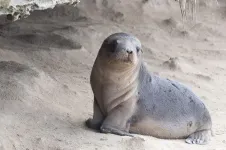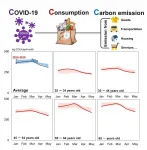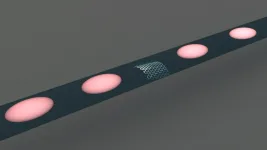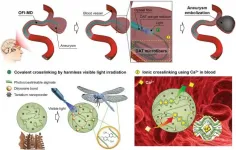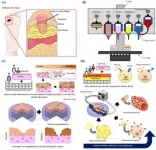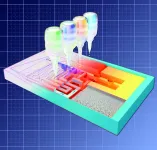(Press-News.org) A chemical that the NSW government has recently partially banned in firefighting has been found in the pups of endangered Australian sea lions and in Australian fur seals.
The finding represents another possible blow to Australian sea lions' survival. Hookworm and tuberculosis already threaten their small and diminishing population, which has fallen by more than 60 percent over four decades.
The new research - part of a long-term health study of seals and sea lions in Australia - identified the chemicals in animals at multiple colonies in Victoria and South Australia from 2017 to 2020.
As well as in pups, the chemicals (Per- and polyfluoroalkyl substances - 'PFAS') were detected in juvenile animals and in an adult male. There was also evidence of transfer of the chemicals from mothers to newborns.
PFAS have been reported to cause cancer, reproductive and developmental defects, endocrine disruption and can compromise immune systems. Exposure can occur through many sources including through contaminated air, soil and water, and common household products containing PFAS. In addition to being used in firefighting foam, they are frequently found in stain repellents, polishes, paints and coatings.
The researchers believe the seals and sea lions ingested the chemicals through their fish, crustacean, octopus and squid diets.
Despite South Australia banning the use of PFAS-containing firefighting foams in 2018, these chemicals persist and don't easily degrade in the environment. They have not been banned in Victoria.
High concentrations
Published in Science of the Total Environment, this is the first study to report concentrations of PFAS in seals and sea lions in Australia.
PFAS concentrations in some animals were comparable to those in marine mammals in the northern hemisphere including southern sea otters and harbour seals.
Particularly high concentrations of the chemicals were found in newborns - transferred during gestation or via their mothers' milk. "This is particularly concerning, given the importance of the developing immune system in neonatal animals," said research co-lead, Dr Rachael Gray from the Sydney School of Veterinary Science.
"While it was not possible to examine the direct impacts of PFAS on the health of individual animals, the results are crucial for ongoing monitoring. With the Australian sea lion now listed as endangered, and Australian fur seals suffering colony-specific population declines, it is critical that we understand all threats to these species, including the role of human-made chemicals, if we are to implement effective conservation management."
Food chain implications
The findings have implications for the entire food chain of which the pups are part, including adult seals and sea lions, fish and even humans.
"Because PFAS last a long time, they can become concentrated inside the tissues of living things. This increases the potential for exposure to other animals in the food chain, particularly top marine mammal predators like seals and sea lions," Dr Gray said.
"There is also the potential for humans to be exposed to PFAS by eating contaminated seafood, drinking contaminated water, or even through eating food grown in contaminated soil.
"So, not only do PFAS threaten native endangered species like the Australian sea lion - they could pose a risk to humans too."
Methodology
A collaboration between the University of Sydney, National Measurement Institute and Phillip Island Nature Parks, the research, chiefly undertaken by University of Sydney PhD student Shannon Taylor, was partly conducted on site at the animals' colonies, with later testing of animal livers at the National Measurement Institute in Sydney. The livers were analysed using a complex method called high-performance liquid chromatograph/triple quadrupole mass spectrometry. At its most basic, this method ionises a molecular compound and then separates and identifies the components based on their mass-to-charge ratio. In this way, specific chemicals and their abundance can be measured.
The endangered Australian sea lion
Dr Rachael Gray and her team of scientists have been conducting world-class research in South Australia in order to save the endangered sea lion.
The Australian sea lion is the only pinniped species endemic to Australian waters, ranging from the Houtman Abrolhos islands off the west coast of Western Australia to the Pages Islands in South Australia. The species is endangered, with a decreasing population trend (International Union for Conservation of Nature Red List) from a low baseline attributed to 19th century commercial sealing.
The small population size increases the species' risk of catastrophic disease impact, as seen in the New Zealand sea lion where neonatal septicaemia and meningitis contributed to 58 percent of pup deaths between 2006 and 2010.
Hookworm infection provides an existing disease pressure for the Australian sea lion. Further, recovery from a significant disease impact would be limited by the species' low reproductive rate. The majority (82 percent) of pup births occur in South Australia where there is dependence on just eight large breeding colonies, including Seal Bay, Kangaroo Island.
INFORMATION:
Declaration
Funding for this research was through the Ecological Society of Australia via a Holsworth Grant to PhD student and lead author Shannon Taylor. The Hermon Slade Foundation provided funding for field support for these ongoing investigations and Sydney School of Veterinary Science bequests also provided financial support. Staff at Seal Bay Conservation Park, Department for Environment and Water, South Australia and Phillip Island Nature Parks provided logistical support.
Despite the rapid and significant changes in consumption patterns witnessed during the initial months of the COVID-19 pandemic, Japanese households maintained their normal levels of greenhouse gases emissions. The "anthropause" -- reduction of human activity due to the pandemic -- made headlines last summer, but factory shutdowns and broken global supply chains did not translate into the adoption of eco-friendly lifestyles for the average household.
"During the early COVID-19 period, we could witness lifestyle changes happening around us fast, so we decided to explore the environmental impacts of these lifestyle changes. Some other research at that period was showing that the production-side greenhouse gases emissions ...
The promise of a quantum internet depends on the complexities of harnessing light to transmit quantum information over fiber optic networks. A potential step forward was reported today by researchers in Sweden who developed integrated chips that can generate light particles on demand and without the need for extreme refrigeration.
Quantum computing today relies on states of matter, that is, electrons which carry qubits of information to perform multiple calculations simultaneously, in a fraction of the time it takes with classical computing.
The co-author of the research, Val Zwiller, Professor ...
Cerebral aneurysms are malformations caused by abnormalities on the walls of blood vessels in the brain. When these blood vessels rupture, about 30% of the sufferers die on the spot, giving these the rightful label of 'ticking bombs in the head'. Recently, a research team at POSTECH has come up with a new treatment that can disassemble these time bombs by filling the aneurysm in blood with a new method.
In order to overcome the shortcomings of coil embolization, POSTECH's joint research team (Professor Joonwon Kim and Dr. Jongkyeong Lim of the Department of Mechanical Engineering with Professor ...
The skin, which covers the surface of the human body, is its largest organ. It is the first organ to show changes stemming from organ or physiological activity. It is especially common for diabetic patients to suffer from skin diseases or infections. Recently, a POSTECH research team has succeeded in creating a 3D artificial skin that enables observation of skin diseases of diabetic patients.
A research team led by Professor Dong-Woo Cho and Minjun Ahn of POSTECH's Department of Mechanical Engineering and Professor Byoung Soo Kim of School of Biomedical Convergence Engineering at Pusan National University has ...
A decade already passed from the first use of bioresorbable vascular scaffold in percutaneous coronary interventions. The first studies - by using surrogate endpoints - showed some superiority of BRS vs. metallic drug-eluting stent in terms of the so-called vascular restoration therapy with recovery of vasomotion and vascular pulsatility when the scaffold was absorbed.
Nevertheless, after these first promising findings, larger and randomized clinical trials and subsequent meta-analyses, powered to hard clinical endpoints, showed that bioresorbable vascular scaffolds, made ...
Researchers at KU Leuven (Belgium) have developed a 3D printing technique that extends the possibilities of lateral flow testing. These tests are widespread in the form of the classic pregnancy test and the COVID-19 self-tests. With the new printing technique, advanced diagnostic tests can be produced that are quick, cheap, and easy to use.
The COVID-19 pandemic has made everyone aware of the importance of rapid diagnosis. The sale of self-tests in pharmacies has been permitted in Belgium since the end of March. This self-test is a so-called lateral flow test. Using a ...
Analysis of The Autopsy, Toxicological, and Psychiatric Reports of Portugal's First Major Forensic Case: Part III
https://doi.org/10.1080/20961790.2021.1898079
Announcing a new article publication for Forensic Sciences Research journal. In this review article the author Ricardo Jorge Dinis-Oliveira of the University Institute of Health Sciences (IUCS)-CESPU, Gandra, Portugal continues a three-part investigation of the "Crime of Flores Street" one of the most famous cases of poisoning which occurred in Portugal in the late 19th century. The case demonstrated the weaknesses of the Portuguese medicolegal system and attests to the importance of toxicological analysis. The first article ...
Most people who are infected with SARS-CoV-2 develop no or only mild symptoms. However, some patients suffer severe life-threatening cases of COVID-19 and require intensive medical care and a ventilator to help them breathe. Many of these patients eventually succumb to the disease or suffer significant long-term health consequences. To identify and treat these patients at an early stage, a kind of "measuring stick" is needed - predictive biomarkers that can recognize those who are at risk of developing severe COVID-19.
First biomarker to predict severity of disease
A team led by Professor Burkhard Becher at the Institute of Experimental Immunology at the University of Zurich, working with researchers from Tübingen, Toulouse and Nantes, has now discovered such ...
Due to the chaotic nature of the atmosphere, weather forecasts, even with ever improving numerical weather prediction models, eventually lose all skill. Meteorologists have a strong desire to better understand this process as they try to trace forecast error back to observational gaps and to provide a means for improvement.
Root mean square error (rms, or its square, the variance distance) is often used to measure differences between simulated and observed fields. In this case, scientists measured the distance between a model forecast field within its grid and the verifying analysis field ...
A pioneering study by UCL scientists has discovered the presence of a harmful inflammatory protein in patients with symptomatic tuberculosis (TB).
Researchers say, by targeting the IL-17 cytokine, a component produced naturally by the immune system in response to infection, excessive and damaging lung inflammation caused by TB may be significantly reduced to help speed up patient recovery.
TB is an infection caused by the bacterium Mycobacterium tuberculosis and is the leading cause of death from infections worldwide. The World Health Organisation estimates that 1.4 million people died of TB disease worldwide in 2019.
Explaining the experimental study, lead author Dr Gabriele Pollara (UCL Division of Infection & Immunity), ...
